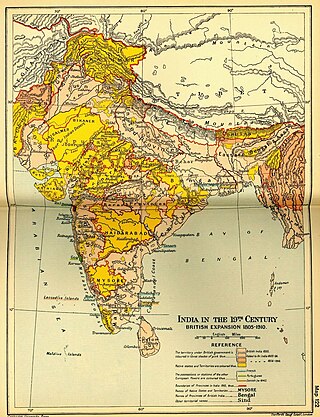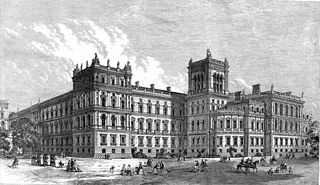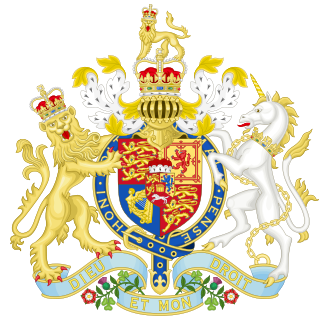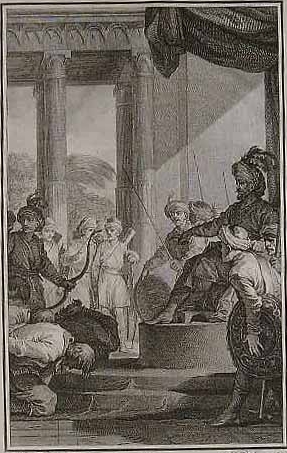
The East India Company (EIC) was an English, and later British, joint-stock company founded in 1600 and dissolved in 1874. It was formed to trade in the Indian Ocean region, initially with the East Indies, and later with East Asia. The company gained control of large parts of the Indian subcontinent and colonised parts of Southeast Asia and Hong Kong. At its peak, the company was the largest corporation in the world by various measures and had its own armed forces in the form of the company's three presidency armies, totalling about 260,000 soldiers, twice the size of the British army at the time.

The Governor-General of India was the representative of the monarch of the United Kingdom in their capacity as the Emperor/Empress of India and after Indian independence in 1947, the representative of the Monarch of India. The office was created in 1773, with the title of Governor-General of the Presidency of Fort William. The officer had direct control only over his presidency but supervised other East India Company officials in India. Complete authority over all of British territory in the Indian subcontinent was granted in 1833, and the official came to be known as the "Governor-General of India".

Company rule in India was the rule of the British East India Company on the Indian subcontinent. This is variously taken to have commenced in 1757, after the Battle of Plassey, when the Nawab of Bengal Siraj ud-Daulah was defeated and replaced with Mir Jafar, who had the support of the East India Company; or in 1765, when the Company was granted the diwani, or the right to collect revenue, in Bengal and Bihar; or in 1773, when the Company abolished local rule (Nizamat) in Bengal and established a capital in Calcutta, appointed its first Governor-General of Fort William, Warren Hastings, and became directly involved in governance. The East India Company significantly expanded its influence throughout the Indian subcontinent after the Anglo-Mysore Wars, Anglo-Maratha Wars, and Anglo-Sikh Wars. Lord William Bentinck became the first Governor General of India in 1834 under the Government of India Act 1833. The Company India ruled until 1858, when, after the Indian Rebellion of 1857 and the Government of India Act 1858, the India Office of the British government assumed the task of directly administering India in the new British Raj.

The Madras Presidency or Madras Province, officially called the Presidency of Fort St. George until 1937, was an administrative subdivision (province) of British India and later the Dominion of India. At its greatest extent, the presidency included most of southern India, including all of present-day Andhra Pradesh, almost all of Tamil Nadu and parts of Kerala, Karnataka, Odisha and Telangana in the modern day. The city of Madras was the winter capital of the presidency and Ooty was the summer capital.

The Bombay Presidency or Bombay Province, also called Bombay and Sind (1843–1936), was an administrative subdivision (province) of British India and later the Dominion of India, with its capital in the city that came up over the seven islands of Bombay. The first mainland territory was acquired in the Konkan region with the Treaty of Bassein. Poona was the summer capital.

The Bengal Presidency, officially the Presidency of Fort William in Bengal, later the Bengal Province, was the largest of all three presidencies of British India during Company rule and later a province of India. At the height of its territorial jurisdiction, it covered large parts of what is now South Asia and Southeast Asia. Bengal proper covered the ethno-linguistic region of Bengal. Calcutta, the city which grew around Fort William, was the capital of the Bengal Presidency. For many years, the Governor of Bengal was concurrently the Governor-General of India and Calcutta was the capital of India until 1911.

The India Office was a British government department in London established in 1858 to oversee the administration of the Provinces of India, through the British viceroy and other officials. The administered territories comprised most of the modern-day nations of the Indian Subcontinent as well as Yemen and other territories around the Indian Ocean. The India Office was headed by the Secretary of State for India, a member of the British cabinet, who was formally advised by the Council of India.

The provinces of India, earlier presidencies of British India and still earlier, presidency towns, were the administrative divisions of British governance on the Indian subcontinent. Collectively, they have been called British India. In one form or another, they existed between 1612 and 1947, conventionally divided into three historical periods:

The East India Company Act 1784, also known as Pitt's India Act, was an Act of the Parliament of Great Britain intended to address the shortcomings of the Regulating Act of 1773 by bringing the East India Company's rule in India under the control of the British Government. Named for British prime minister William Pitt the Younger, the act provided for the appointment of a Board of Control, and provided for a joint government of British India by the Company and the Crown with the government holding the ultimate authority. A six-member board of control was set up for political activities and Court of directors for financial/commercial activities. As the Regulating Act had many defects, it was necessary to pass another Act to remove these defects.
The sport of cricket was introduced to the Indian subcontinent by sailors and traders of the English East India Company in the 17th and 18th centuries. The earliest known record of cricket in India dates from 1721 and the first club had been founded by 1792. In the 1886 and 1888 summer seasons, the Parsees cricket team toured England. In the winter of 1889–90, a team of English players was the first to tour India, followed by another in the 1892–93 season. That tour coincided with the beginning of competitive cricket in the country as the Parsees won the prestigious Bombay Presidency Match against the Europeans cricket team. By 1912–13, the tournament had become the Bombay Quadrangular with the addition of the Hindus cricket team and the Muslims cricket team. Similar tournaments began soon afterwards in Calcutta and Madras. By the end of 1918, first-class cricket was established in India.
Taxation of salt has occurred in India since the earliest times. However, this tax was greatly increased when the British East India Company began to establish its rule over provinces in India. In 1835, special taxes were imposed on Indian salt to facilitate its import. This paid huge dividends for the traders of the British East India Company. When the Crown took over the administration of India from the Company in 1858, the taxes were not replaced.

The presidency armies were the armies of the three presidencies of the East India Company's rule in India, later the forces of the British Crown in India, composed primarily of Indian sepoys. The presidency armies were named after the presidencies: the Bengal Army, the Madras Army and the Bombay Army. Initially, only Europeans served as commissioned or non-commissioned officers. In time, Indian Army units were garrisoned from Peshawar in the north, to Sind in the west, and to Rangoon in the east. The army was engaged in the wars to extend British control in India and beyond.
The Indian independence movement had a long history in the Tamil-speaking districts of the then Madras Presidency going back to the 18th century.

Coinage under British governance of the Indian subcontinent can be divided into two periods: East India Company (EIC) issues, pre-1835; and Imperial issues struck under direct authority of the crown. The EIC issues can be further subdivided into two subcategories: the Presidency issues, which comprise separate Madras Presidency, Bombay Presidency, and Bengal Presidency issues; and uniform coinage for all British territories from 1835 to 1858. Imperial issues bear obverse portraits of Queen Victoria, Edward VII, George V, and George VI. No British India coins were issued during the brief reign of Edward VIII.

The Anglo-Mughal war, also known as the Child's war, was the first Anglo-Indian war on the Indian subcontinent.

The East India Company Act 1813, also known as the Charter Act 1813, was an Act of the Parliament of the United Kingdom that renewed the charter issued to the British East India Company, and continued the Company's rule in India. However, the Company's commercial monopoly was ended, except for the tea and opium trade and the trade with China, this reflecting the growth of British power in India.

The Government of India Act 1833, sometimes called the East India Company Act 1833 or the Charter Act 1833, was an Act of the Parliament of the United Kingdom, later retitled as the Saint Helena Act 1833. It extended the royal charter granted to the East India Company for an additional twenty years, and restructured the governance of British India.
The Bombay Opium Trade started in the late eighteenth century and was an incredibly profitable industry that played a significant role in shaping the economic and social landscape of Bombay. At this time, India was a major producer of opium, and the British East India Company held a monopoly on its production. Indigenous merchants, traders, and smugglers were central figures in this trade, despite the Company's regulatory efforts. Smuggling was an effective method for evading legal restrictions and taxes imposed on the opium trade. Indigenous smugglers used hidden routes and operated covertly to transport and sell opium. This effort sustained and expanded the opium industry, which had widespread economic consequences, including the development of a capitalist class in Bombay.











